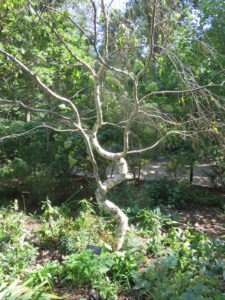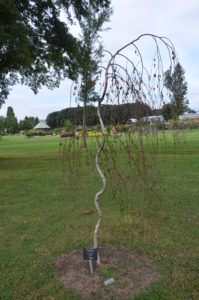Young’s Weeping European Birch (Betula pendula ‘Youngii’) is small graceful tree with willowy pendulous branches (USDA hardiness zones 3-6). Nurseries often train the very pliable branches and trunk of grafted seedlings into unique novelty shapes.
Plant this miniature 12 to 20 feet tree specimen near a deck or patio where it should receive mostly morning sunlight. Fall foliage turns bright yellow. In late winter 3-inch male catkins, hanging from its slender branches swell, a sure signal that spring is close at hand.
The key to growing Youngi (or any white bark birch) successfully is to maintain a stress-free growing setting. This noveltry tree requires more care and pesticide spraying than most landscape plants. Unfortunately, twigs and branches are highly susceptible to bronze birch borers and leaf miners which turn leaves brown by late summer unless sprayed every few weeks. Apply the proper insecticidal controls and cultural conditions for best growth.
When planted in cool temperate areas of the U.S., particularly in northern tier of New England and Midwestern states, European birches live several decades. The tree’s leaf canopy is not dense and surface roots tend to dry out rapidly. Irrigate deeply the first growing season to develop an extensive root system. Maintain a 2-3 inch mulch depth around the root zone to cool surface roots. Weekly summer irrigation also aids in cooling the ground. Feed with slow release fertilizer in early spring.
Pruning, if needed, should be performed in summer to early fall and do not prune excessively. Spring pruning should be avoided as sap will bleed profusively from pruning cuts; sooty mold disease frequently follows, growing over sweet sap and blackening the beautiful white sap. Avoid excessive pruning, e.g. removing more than 20% of total branching. Pruning at the wrong time also can lead to borer infestations.



 Posted in
Posted in 
